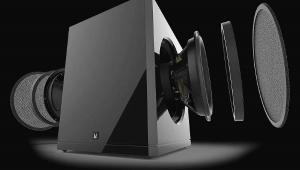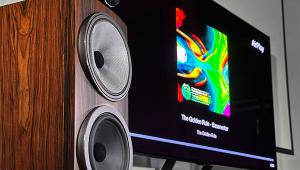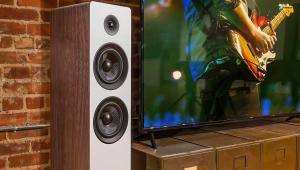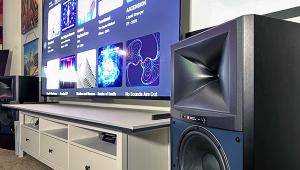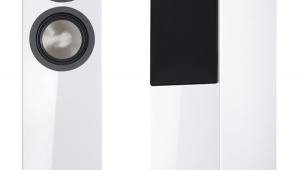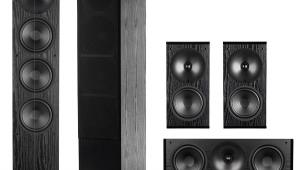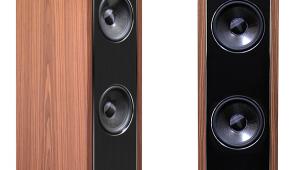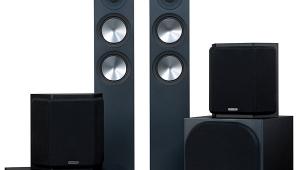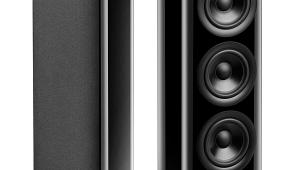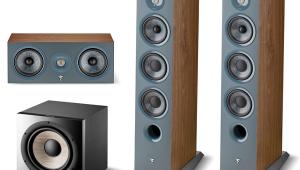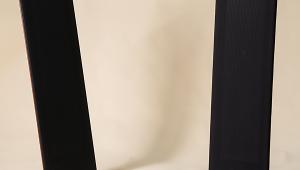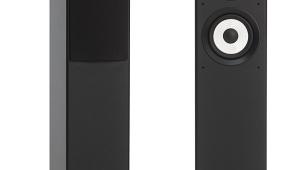GoldenEar Technology TritonCinema Two Page 2
Something Old, Something New
One of the most fascinating parts of the GoldenEar speakers is the company’s High-Velocity Folded Ribbon (HVFR) tweeter. This driver isn’t a ribbon, strictly speaking, as its diaphragm isn’t electrically conductive in and of itself. Nevertheless, the HVFR isn’t another variant of the standard, off-the-shelf dome tweeter. Such tweeters move a dome, often made from materials as diverse as silk or beryllium, rapidly back and forth—like a piston in an engine—to compress and rarefy air in the room. Nor is the HVFR like the less common conventional ribbon and planar magnetic tweeters that rapidly move a thin, flat diaphragm back and forth (again, like a piston) within a magnetic field. Instead, the HVFR uses a thin, high-temperature-tolerant plastic film that’s folded multiple times so
it looks like the sides of an accordion with the pleats facing forward. When modulated by the audio signal, the pleats squeeze the air between them, creating sound. So what’s the big deal about squeezing? Very simply, squeezing is much more efficient at compressing air than pistonic action. In fact, in a folded-diaphragm tweeter, the velocity of the air relative to the speed of the moving diaphragm is approximately four times more than what you get with a dome tweeter. All those folds also mean that the acoustically effective surface area of a folded ribbon tweeter is around two-and-a-half times that of an equivalently sized dome tweeter assembly.

GoldenEar says this provides for better impedance matching with the air and allows for greater control of the diaphragm. Aside from being cool to talk about at parties (although, remember, don’t put your beer on top of the speakers), the claimed benefits are extended frequency response and greater dynamic capability. The design is a descendant of the Heil Air Motion Transformer tweeter from the 1970s. It wasn’t widely used in the past partly due to the fact that the materials capable of withstanding the high temperatures and stresses created by the squeezing action weren’t readily available. Plus, the bipolar nature of the original design was difficult to implement in a speaker with a conventional woofer and cabinet. In other words, it was slightly ahead of its time. The design of GoldenEar’s new tweeter is meant to address those issues, and the company uses a similar HVFR tweeter in the Triton Two, the SuperSat 50C, and the little SuperSat 3. That can be a plus when it comes to creating a coherent and seamless surround soundfield.

Oh-so-cool accordion-style tweeters aren’t the only interesting thing behind the grilles. In the Triton Two, there are two cast-basket, upper bass/midrange polypropylene drivers arranged in a D’Appolito array above and below the tweeter. Engineered properly, the D’Appolito array affects the interaction between the drivers, which helps control dispersion. GoldenEar says these mid/bass drivers can achieve a smooth linear response over a large range, although they’re crossed over at 3.5 kilohertz. Using such a small sliver of their sonic capabilities helps to ensure optimal performance.
 Then There’s the Woofer
Then There’s the Woofer
Remember the mistake I thought GoldenEar made when it didn’t send a sub with the system? Well, it was no mistake, as I soon found out after I fired up the system. The Triton Twos not only don’t need a subwoofer, they’ll send most standalone subs running home to mommy with their power cord between their legs. On the front of each Triton Two is a pair of 5-by-9-inch oblong or racetrack-shaped front-mounted woofers. They’re coupled by the air in the box to a pair of side-mounted (one on each side) 7-by-10-inch rectangular passive radiators. All of that wooferage is powered by a claimed 1,200-watt switching amplifier with builtin DSP, which Gross says provides extremely linear and low-distortion response. In addition, the DSP circuitry dynamically controls the operating parameters of the subwoofer system (soft clipping, DC offset control, and discrete multi-band limiting) to continually optimize the performance. Although there is an LFE input on the back of each Triton Two, GoldenEar recommends that you hook up the speakers using speaker level and run them as full range in your bass-management parameters. If you do decide to hook up the system this way (and I did), you won’t have to run a separate cable to each speaker from the surround processor sub-out. So what you essentially get is a pair of 1,200-watt subwoofers with a total of four active and four passive drivers—and no separate boxes to find a space in your room for.
Don’t Be Coy, Roy
I could be coy and make you read a little further before I gave you my overall opinion, but what’s the point? Let me just say it at the outset. The TritonCinema Two system is spectacularly spectacular. That HVFR tweeter is a thing of audible beauty. It sounds truly dynamic and smooth throughout its frequency range and so delicate and light that it’s reminiscent of the sound you get with a good (but much larger) electrostatic speaker. For example, “The Ballad of Bill Hubbard,” the first track on Roger Waters’ Amused to Death (featuring Jeff Beck on guitar) begins with an extremely quiet voice far to the left. With the Triton Twos, it’s very far to the left, farther than you’d think possible. The soundstage is extremely wide. Despite the low volume level, the voice is quite intelligible. Not long into the piece, a dog begins barking in the distance. With the Triton Twos, the dog bark was so realistic and so well placed behind the speakers that at first I thought it was one of my own dogs barking outside the house. It was so uncannily good that the second time I played it, the effect still caught me off guard.
